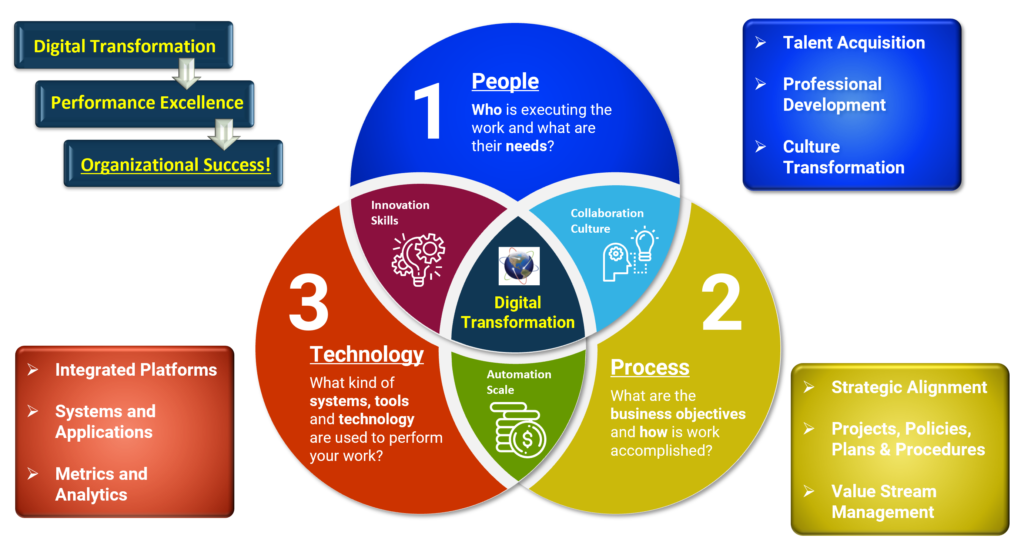Digital Transformation
- With the speed at which digital technologies are evolving, organizations have had to accelerate the adoption of a flexible digital transformation strategy that includes a holistic approach spanning across the enterprise.
- For leaders, the development of a digital transformation strategy comes with its own distinct set of challenges – from both a technical and cultural perspective.
- The interaction between people, digital technologies, and physical assets has created an increasingly fast-paced and complex environment that requires organizations to create agile and dynamic workflows to remain highly competitive.
Enjoy this brief video from the Digital Transformation Expo that highlights the key aspects and challenges for organizational leaders. (2:06 minutes)
High-Level Strategic Areas
Digital transformation occurs within three strategic areas across an organization: People, Process, and Technology
- It is recognized that there are a multitude of approaches, models, and vendors that offer a variety of services.
- Generally, these are the three main areas, however unique and tailored strategies are required.
- Proper project planning and due diligence is required before starting your journey.

Enterprise Service Management
- IT Service Management (ITSM) is how IT teams manage the end-to-end delivery of IT services to customers. This includes all the processes and activities to design, create, deliver, and support IT services.
- Enterprise Service Management is the practice of applying IT service management to other areas of an enterprise or organization with the purpose of improving performance, efficiency, and service delivery - delivering enterprise solutions and business value.
- Gartner 2022 release of the Magic Quadrant for IT Service Management Tools is shown below indicating the major platforms in the marketplace. The top 4 are ServiceNow, BMC, Ivanti, and Atlassian.


It is a strategic imperative that organizations evaluate and adopt a platform to meet their critical business needs.
ServiceNow Platform
- ServiceNow brings together discrete service support tools into a single system-of-record, providing a unified operational view, delivering resilient services that increase productivity, and create amazing experiences for employees and customers.
- Core functional capabilities include IT Service Management, IT Operations Management, IT Business Management, Customer Service Management, Intelligent Apps, HR Service Delivery, Security Operations, Asset Management, and Governance, Risk, & Compliance (GRC).
- Each of these functional capabilities are comprised of applications and practices that automate workflow and provide optimized processes that deliver business value across the enterprise.

Common ITSM Practice Areas
- The ITIL Practice Areas below, are a sample of the most common processes within IT Service Management.
- Each area has its own defined requirements, use cases, detailed workflows, metrics and reports, roles and responsibilities, and related process documentation.
- These vital practices need to be designed and tailored to meet your business goals and objectives for operational excellence.
Incident Management
Automatically assign incidents to the correct resolution group with Incident Management's machine learning. Bring together stakeholders to investigate issues and restore services swiftly with the Major Incident Management. Quick resolution is the key!
Problem Management
Restore services quickly and often prevent issues from happening in the first place with Problem Management. Structured workflows diagnose root causes and fix problems to eliminate recurring incidents and minimize the impact of unexpected disruptions.
Change Management
Improve velocity of work while minimizing risks and costs of unplanned changes. Automate changes with DevOps capabilities and for complex changes, automate change advisory board meetings with a CAB workbench to accelerate change management.
Request Management
Give employees a modern, omni-channel way to interact 24/7 with IT and other shared services groups using any device to enable self-help, collaboration, request items or services, and get automated status updates to ensure expectation are met.
Configuration Management
Consolidate IT data silos into a single system of record to let IT see the functioning of all assets and related services. See the relationships of configuration items (CIs) and services to proactively manage the change impacts (CMDB).
Asset Management
Avoid unnecessary asset purchases, cut software licensing and support costs by tracking the financial, contractual, and inventory of hardware and virtual assets from purchase through disposal with Asset Management.
Service Level Management
Set business expectations and gain visibility into your IT team's service commitments and performance with Service Level Management. Prioritize tasks, check statuses, reassign ownership, escalate issues, and manage SLAs.
Knowledge Management
Share, manage, and use knowledge from across the organization and make it readily available for shared or private use by IT and employees. Increase employee self-service and boost agent productivity with contextual knowledge, driven by machine learning.
To help support your initiatives and mature your systems and processes, ITIL 4 now provides 34 Practices that are robust, dynamic, and tailorable to help you define your critical product and service offerings.

"The ITIL 4 and DevOps frameworks with their advanced certification courses provide the knowledge, skills, and resources to significantly support digital transformation initiatives. Upskill your staff to meet the demands of a highly-trained and engaged modern workforce. Worthy of deep consideration!"
- Rusty Robinson -
See Corporate Training for more information


